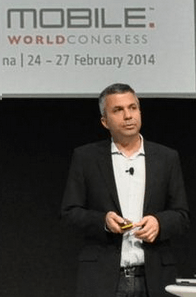Yuval Ben-Itzhak
Yuval Ben-Itzhak is an executive and entrepreneur. He received a number of honors and public recognition for his work as a Chief Technology Officer throughout his career. Ben-Itzhak has been selected as the 25 most influencing CTO by InfoWorld, 40 Innovative IT People To Watch by Computerworld, and 2017 Chief Technology Officer of the Year by GeekTime. He was the Chief Technology Officer at AVG and was part of the leadership team that took AVG through its initial public offering on the New York Stock Exchange in 2012. He was the Chief Technology Officer at Outbrain until 2017, and now is the Chief Executive Officer at Socialbakers.
Yuval Ben-Itzhak | |
|---|---|
 Keynote at the 2014 Mobile World Congress | |
| Born | Israel |
| Alma mater | Ben-Gurion University, B.Sc Information systems, Management & Industrial Engineering (Cum Laude) |
| Occupation | Chief Executive Officer at Socialbakers |
Career
- 2017–Present: Chief Executive Officer, Socialbakers[1]
- 2015–2017: Chief Technology Officer, Outbrain[2]
- 2009–2015: Chief Technology Officer, AVG Technologies (NYSE: AVG)
- 2005–2009: Chief Technology Officer, Finjan Inc.
- 2000–2004: Chief Technology Officer, Founder, KaVaDo Inc.
- 1998–2000: Chief Technology Officer, Ness Technologies (Nasdaq: NSTC)
- 1994–1996: Software development & management, Intel Corp. (Nasdaq: INTC)
- 1988–1992: Intelligence services, IDF
Awards
- 2017 – Chief Technology Officer of the Year by GeekTime[3]
- 2007 – 40 Innovative IT People To Watch by Computerworld[4]
- 2004 – Top 25 Most Influential CTOs by InfoWorld[5]
Patents
- US 9,525,680 – Splitting an SSL connection between gateways
- US 9,514,477 – Systems and methods for providing user-specific content on an electronic device
- US 9,424,422 – Detection of rogue software applications
- US 9,294,493 – Computer security method and system with input parameter validation
- US 9,288,226 – Detection of rogue software applications
- US 9,280,391 – Systems and methods for improving performance of computer systems
- US 9,110,595 – Systems and methods for enhancing performance of software applications
- US 9,058,612 – Systems and methods for recommending software applications
- US 8,769,690 – Protection from malicious web content
- US 8,732,831 – Detection of rogue software applications
- US 8,566,580 – Splitting an SSL connection between gateways
- US 8,141,154 – System and method for inspecting dynamically generated executable code
- US 8,087,079 – Byte-distribution analysis of file security
- US 8,015,182 – System and method for appending security information to search engine results
- US 7,930,299 – System and method for appending security information to search engine results
- US 7,882,555 – Application layer security method and system
- US 7,757,289 – System and method for inspecting dynamically generated executable code
- US 7,614,085 – Method for the automatic setting and updating of a security policy
- US 7,613,918 – System and method for enforcing a security context on a downloadable
- US 7,313,822 – Application-layer security method and system
gollark: The machine code for them is excessively complex too, now, but I suppose you mostly write Haskell and whatnot which is then compiled to that.
gollark: They have ridiculously complex manufacturing processes because the transistors are on the scale of a few hundred atoms, it's crazy.
gollark: Also, with your processor comment, you are kind of underselling the complexity involved. It's not separate transistors, they're all just made on large bits of silicon together and wired up. Billions of them per processor.
gollark: In the case of games, which are basically just *information*, though, you can both use it because it can be copied (assuming no DRM meddling).
gollark: Quantum electrodynamics is still an important field of study.
References
- socialbakers.com https://www.socialbakers.com/company/for-press/releases/98-socialbakers-appoints-yuval-ben-itzhak-as-chief-executive-officer. Missing or empty
|title=(help) - prnewswire.com https://www.prnewswire.com/news-releases/outbrain-taps-yuval-ben-itzhak-as-first-chief-technology-officer-300078236.html. Missing or empty
|title=(help) - "Geek Awards 2017 recognize Israel's startup ecosystem leaders". Geektime.com. 2017-01-26. Retrieved 2017-07-27.
- 40 Innovative IT People To Watch Archived March 2, 2007, at the Wayback Machine
- 25 most influencing CTO Archived December 17, 2013, at the Wayback Machine
This article is issued from Wikipedia. The text is licensed under Creative Commons - Attribution - Sharealike. Additional terms may apply for the media files.